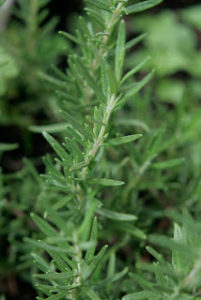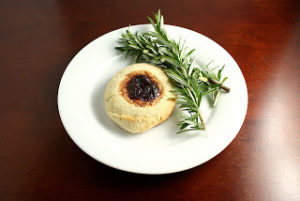Rosemary, Rosmarinus officinalis, is a woody, perennial herb that is part of the Lamiaceae family (aka the mint family). The name rosemary derives from the latin rosmarinus, which broken down further means ros~dew, and marinus~sea. Many contend that rosemary was given this name because it required very little water to survive and could literally sustain itself and even thrive on moist on-shore breezes.

Photo of Rosemary provided by Cinnamon Cooper.
Rosemary is a plant that can grow under many climactic circumstances, however it originated in the mediterranean climates of Europe and parts of Asia. It maintains its hardiness in cool temperatures and can withstand droughts, but it is best situated in warm, mediterranean climates. Rosemary can flower year round with the proper climate; it produces petals in white, purple, and blue–these are also edible, or they can be used for garnish. Rosemary can be started from seed or you can take a cutting of an existing plant and plant it in your own backyard.
To use the cutting technique, look for a stem without flowers that is about 4-7 inches long. Clip the base of the stem at a 45 degree angle. Place the newly cut stem into a clear glass of water (if you can’t submerge the stem in water right away, wrap it in a wet cloth until you can). After a week the rosemary cutting will begin to grow roots and after two weeks the roots should be long enough to replant the cutting. If your cutting does not sprout roots after 9-10 days, try taking another cutting and start from scratch. The best time to try the cutting technique is in the fall, when the stem will spend more energy developing roots as opposed to trying to produce flowers.
Rosemary is a highly aromatic herb that has many culinary properties. It has been used as a meat preservative, a flavorant, and in smoking applications (since it is rather woody). It has a very strong scent and flavor and people tend to cook or pair it with other robust flavors like red meats, mushrooms, and red wines, but rosemary has some subtler applications that many cooks can appreciate. For example, the recipe described below mixes rosemary with sugar, jam, and cream:

Photo of Rosemary Scone courtesy of esimpraim.
Rosemary scones are not your typical sweet and candied confection. The addition of rosemary brings a whole new layer of depth and flavoring to the scone. To achieve the subtle flavoring, make sure you chop the rosemary leaves finely and toss out any of the wooden stems. Also, you may add whatever jam you prefer to the center of the scone, but I prefer raspberry or strawberry. Here is a link to a Strawberry and Rosemary Scone recipe created by Giada de Laurentiis: http://www.foodnetwork.com/recipes/giada-de-laurentiis/strawberry-and-rosemary-scones-recipe/index.html.
ENJOY!
